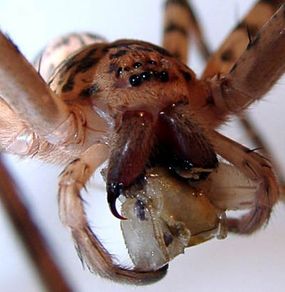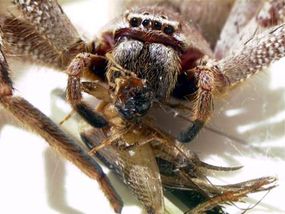Spider Venom
Whatever their hunting strategy, the vast majority of spiders follow the same basic killing and feeding procedure. The spider's primary weapon is its chelicerae, a pair of jointed jaws in front of the mouth. Each jaw has two major parts: the basal segment, the bulk of the jaw, and the sharp fang housed inside of it.
Normally, the fang is retracted inside the basal segment. When the spider catches its prey, it swings the fangs out into the animal's body. The fangs work something like hypodermic needles. They have a small hole in the tip and a hollow duct inside. The duct leads to the venom gland, either inside the basal segment or farther back in the cephalothorax. When the spider pierces its prey with the fang, it squeezes out the venom, injecting the animal with enough neurotoxin to paralyze or kill. This makes it safe for the spider to feed on its prey, without the risk of a struggle.
Advertisement
In the mygalomorph spider suborder, which includes the various tarantulas, the chelicerae are positioned so that the fangs swing forward into the prey, like an axe. In the dominant araneomorph suborder, the chelicerae swing in toward each other, like a pincer. For the mygalomorph system to work effectively, the prey has to be on ground or another solid surface -- the spider has to sandwich the prey between something else and the fangs. The araneomorph system works whether or not the prey is on solid ground -- the chelicerae simply push against each other.


After paralyzing its prey, some spiders may wrap it up in silk to make it easier to transport back to the nest. Some species actually cover the prey in silk before injecting the venom, making it easier to attack. A female spider may carry wrapped prey back to its young spiderlings, and a male may bring the wrapped prey to a female as a courtship gift.
Most spiders don't eat their prey whole; instead, they expel digestive enzymes onto or into the animal to liquefy it. Some spiders use their fangs to inject the digestive fluid directly into the animal. This sort of spider liquefies the animal's insides, leaving the exoskeleton more or less intact. Then it sucks the liquefied remains into its stomach through hairs on its chelicerae and mouth, which act as a filter. Other species chew their prey up with serrated "teeth" on the chelicerae before vomiting digestive fluid on the body and sucking in the liquid remains.
